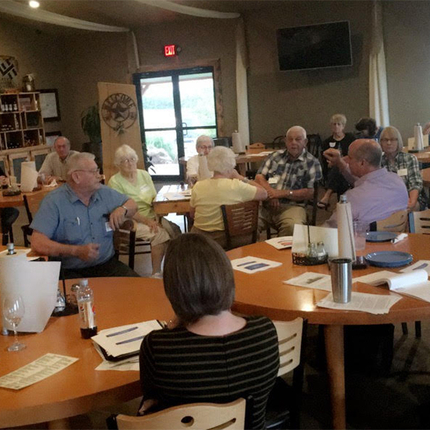By Henry Miller, former staff member
Nebraskans work together; we’ve always had to. When big issues arise that affect our state, we get fired up.
Agricultural property taxes have come to the forefront of debate as they serve as the primary funding source of K-12 schools, community colleges, roads, and law enforcement. Nebraska, traditionally having a strong agricultural revenue source, has placed a heavy dependency on property taxes as a funding pipeline for these services. However, as the agricultural sector continues to take a financial hit, Nebraska’s overreliance on agricultural property tax is even more pronounced, further displaying the unsustainability of the current tax system.
This imbalance was the topic of conversation during a recent meeting hosted by the Center for Rural Affairs near Ohiowa, in rural Fillmore County. Residents from five neighboring counties attended, with representatives including school superintendents, business owners, farmers, elected officials, and community members.
A common theme quickly emerged; Nebraskans are being suffocated by property taxes and are unsure where to direct their energy in order to bring about effective change to the tax system.
During the meeting, Dennis Richters, of Utica, and member of the Fair Nebraska organization said, “We have a right to be angry, but our anger is misplaced.”
From 2005 to 2014, property taxes on agricultural land increased an average 11 percent each year due to dynamic shift in land values. This opened the door for an overreliance on local funding for counties, Natural Resources Districts (NRD), community colleges, and public schools.
Nebraska’s school systems often take the brunt of this frustration, as the state’s current education funding formula leaves schools with little option but to rely on agricultural land property tax as the primary revenue source.
While schools depend heavily on local property tax collections for funding, Fairbury Public Schools Superintendent Stephen Grizzle demonstrated that this dependency was not a result of excessive spending increases. Over the last seven years, Fairbury schools saw an average 2.4 percent increase in spending, increases associated with everyday rising costs in salaries, health care benefits, and basic supplies.
And yet Grizzle noted, “The governor and senators tout out-of-control local spending as the culprit of high property taxes, but this simply isn’t the case. Yes, local entities are asking landowners for dollars, but this is only because this is the system we are working with.”
When land valuations exceed the cost of schools needs, state funding is largely removed from the equation, leaving schools with no other choice but to call on landowners for revenue. Nebraska ranks 49th in the country in the percentage of K-12 funding that comes from the state.
Despite this limited investment from the state, Nebraskans want to maintain these quality schools; but where the funding comes from and what is done with the money creates community tension.
Hebron business woman, Deb Craig, shared, “If we don’t have quality school infrastructures and we keep our taxes so low, and our schools fall apart, what incentive do our children or other young people with families have to come to our communities?”
For rural towns, schools are often the epicenter of the community. School systems draw and keep people in the community, provide employment, and create a sense of pride in a place.
However, the funding of this vital community asset can also be a point of contention.
“You can do a lot of damage in a small community because school funding is a very emotional issue,” noted Craig, speaking from her experience as a former school board member for Thayer Central Public Schools. “If we could simply step back and look at the big picture, we will create better conversations and arrive at real solutions.”
As low commodity prices and high ag land property taxes continue to drive emotion and anxieties in rural communities across Nebraska, the wisdom afforded by Craig and Superintendent Grizzle needs to be noted and dually applied. By collectively stepping back to see the bigger picture and holding back on appointing blame, Nebraskans can come together to find solutions that meet school funding needs while providing much needed tax relief to the state’s ag land owners.
Check out the Center for Rural Affairs’ event calendar for upcoming community conversations in your area.





